
Accordions are a family of box-shaped musical instruments of the bellows-driven free reed aerophone type. The essential characteristic of the accordion is to combine in one instrument a melody section,also called the diskant,usually on the right-hand keyboard,with an accompaniment or Basso continuo functionality on the left-hand. The musician normally plays the melody on buttons or keys on the right-hand side,and the accompaniment on bass or pre-set chord buttons on the left-hand side. A person who plays the accordion is called an accordionist.
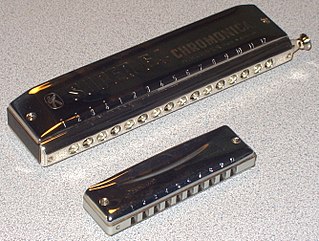
The harmonica,also known as a French harp,mouth harp or mouth organ,is a free reed wind instrument used worldwide in many musical genres,notably in blues,American folk music,classical music,jazz,country,and rock. The many types of harmonica include diatonic,chromatic,tremolo,octave,orchestral,and bass versions. A harmonica is played by using the mouth to direct air into or out of one holes along a mouthpiece. Behind each hole is a chamber containing at least one reed. The most common is the diatonic Richter-tuned with ten air passages and twenty reeds,often called the blues harp. A harmonica reed is a flat,elongated spring typically made of brass,stainless steel,or bronze,which is secured at one end over a slot that serves as an airway. When the free end is made to vibrate by the player's air,it alternately blocks and unblocks the airway to produce sound.
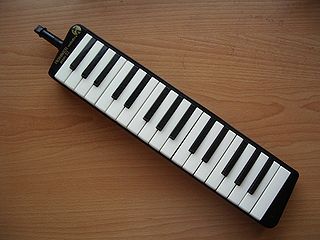
The melodica is a handheld free-reed instrument similar to a pump organ or harmonica. It features a musical keyboard on top,and is played by blowing air through a mouthpiece that fits into a hole in the side of the instrument. The keyboard usually covers two or three octaves. Melodicas are small,lightweight,and portable,and many are designed for children to play. They are popular in music education programs,especially in Asia. The modern form of the instrument was invented by Hohner in the late 1950s,though similar instruments have been known in Italy since the 19th century.

The sheng is a Chinese mouth-blown polyphonic free reed instrument consisting of vertical pipes.

Korean court music comprises three main musical genres:aak,an imported form of Chinese ritual music;a pure Korean form called hyangak;and a combination of Chinese and Korean styles called dangak.
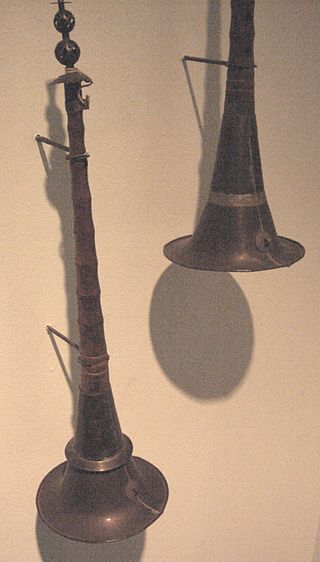
Suona,also called dida,laba or haidi,is a traditional double-reeded Chinese musical instrument. The Suona's basic design originated in ancient Iran,then called "Sorna". Suona appeared in China around the 3rd century. It had a distinctively loud and high-pitched sound,and was used frequently in Chinese traditional music ensembles,particularly in those that perform outdoors. It was an important instrument in the folk music of northern China,particularly in provinces of Shandong and Henan,where it has long been used for festival and military purposes. It is still being used,in combination with sheng mouth organs,gongs,drums,and sometimes other instruments in weddings and funeral processions. Such wind and percussion ensembles are called chuida or guchui. Stephen Jones has written extensively on its use in ritual music of Shanxi. It was also common in the ritual music of Southeast China. In Taiwan,it was an essential element of ritual music that accompanied Daoist performances of both auspicious and inauspicious rites,i.e.,those for both the living and the dead. One of the most famous pieces that uses suona as the leading instrument is called "Bai Niao Chao Feng",or "Hundred Birds Worship the Phoenix". The movie Song of the Phoenix casts the rise and fall of the popularity of suona in modern Chinese musical history.

Music of Northeast China is tied closely to the region's history. Musical traditions of the Bang Zi Theatre and folk instruments such as the Dizi,Xiao and Baijiao Gu originate in the region. Folk songs from the north east are noted for their contributions toward nationalistic music the popular communist-era song “The East is Red”based upon a traditional Northern Shaanxi melody. The popularity of western musical traditions in the Harbin province are internationally recognised with the northern city being named a ‘music city’in 2010 by the United Nations. Contemporary folk as well as modern pop music continue to contribute to the diverse musical traditions of the region. Prominent performers from the Northeast include the mid-20th-century film composer Lei Zhenbang and pop stars Xiao Ke and Na Ying.

The term Chinese orchestra is most commonly used to refer to the modern Chinese orchestra that is found in China and various overseas Chinese communities. This modern Chinese orchestra first developed out of Jiangnan sizhu ensemble in the 1920s into a form that is based on the structure and principles of a Western symphony orchestra but using Chinese instruments. The orchestra is divided into four sections –wind,plucked strings,bowed strings,and percussion,and usually performs modernized traditional music called guoyue. The orchestra may be referred to as Minzu Yuetuan or Minyuetuan in mainland China,Chung Ngok Tuen in Hong Kong,Huayuetuan in Southeast Asia,or Guoyuetuan in Taiwan.

Korean arts include traditions in calligraphy,music,painting and pottery,often marked by the use of natural forms,surface decoration and bold colors or sounds.
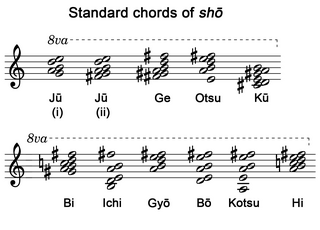
The shō (笙) is a Japanese free reed musical instrument that was introduced from China during the Nara period. It is descended from the Chinese sheng,of the Tang Dynasty era,although the shō tends to be smaller in size than its contemporary sheng relatives. It consists of 17 slender bamboo pipes,each of which is fitted in its base with a metal free reed. Two of the pipes are silent,although research suggests that they were used in some music during the Heian period. It is speculated that even though the pipes are silent,they were kept as part of the instrument to keep the symmetrical shape.

The konghou is a Chinese plucked string instrument. In ancient China,the term konghou came to refer to three different musical instruments:a zither and two different types of harp.
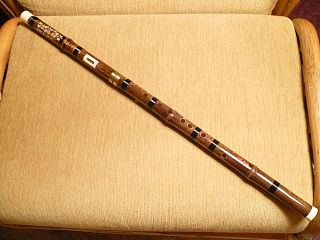
The bawu is a Chinese wind instrument. Although shaped like a flute,it is actually a free reed instrument,with a single metal reed. It is played in a transverse (horizontal) manner. It has a pure,clarinet-like timbre and its playing technique incorporates the use of much ornamentation,particularly bending tones.

The taepyeongso is a Korean double reed wind instrument in the shawm or oboe family,probably descended from the Persian sorna and closely related to the Chinese suona. It has a conical wooden body made from yuja (citron),daechu (jujube),or yellow mulberry wood,with a metal mouthpiece and cup-shaped metal bell. It originated during the Goryeo period (918–1392).
The guan is a Chinese double reed wind instrument. The northern Chinese version is called guanzi or bili and the Cantonese version is called houguan. It is classified as a bamboo instrument in the Ba Yin system. Unlike other instruments in the double-reed family of woodwinds which mostly have conical bores,such as the Chinese suona or the Western oboe,the guan has a cylindrical bore,giving its distinctive mellow,yet piercing buzz-like timbre.

Bianzhong is an ancient Chinese musical instrument consisting of a set of bronze bells,played melodically. China is the earliest country to manufacture and use musical chimes. They are also called chime bells. These sets of chime bells were used as polyphonic musical instruments and some of these bells have been dated at between 2,000 to 3,600 years old. They were hung in a wooden frame and struck with a mallet. Using a wooden hammer and a rod to beat the bronze bell can make different pitch. Along with the stone chimes called bianqing,they were an important instrument in China's ritual and court music going back to ancient times.

The haegeum (Korean: 해금) is a traditional Korean string instrument,resembling a vertical fiddle with two strings;derived from the ancient Chinese xiqin. It has a rodlike neck,a hollow wooden soundbox,and two silk strings,and is held vertically on the knee of the performer and played with a bow. It is also popularly known as kkangkkang-i (깡깡이),kkaengkkaeng-i (깽깽이),or aeng-geum (앵금).
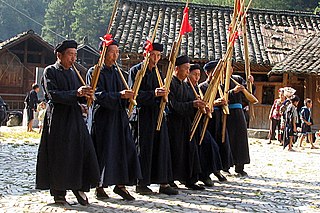
The lusheng is a Hmong musical instrument. It has a long history of 3000 years in China,traced back to the Tang Dynasty. It is a mouth organ with multiple bamboo pipes,each fitted with a free reed,which are fitted into a long blowing tube made of hardwood. It most often has five or six pipes of different pitches and is thus a polyphonic instrument. Its construction includes six parts. It comes in sizes ranging from very small to several meters in length.

The tungso is a Korean notched,end-blown vertical bamboo flute used in Korean traditional music. It is similar to the danso,but longer and larger. The hanja tong (洞) was used to describe the shape of the instrument that resembles a long cave.

The bipa is a pear-shaped lute that is a traditional Korean musical instrument. It is derived from Chinese pipa and was introduced through the Silk Road to Goguryeo and Silla. There are two major types of bipa:the four stringed dang-bipa and the five stringed hyang-bipa. While dang-bipa was a Tang-style pipa first introduced from the Chinese Tang dynasty and localized over time to have Korean characteristics,hyang-bipa was created in the Korean Kingdom of Silla. The instrument is also related to other derivatives such as Vietnamese đàn tỳbà and the Japanese biwa.

The gourd mouth organ is a free reed mouth organ played across East and Southeast Asia. It consists of a gourd wind chest with several bamboo or bronze pipes inserted on top of it,the numbers of pipes differing from region to region.




















